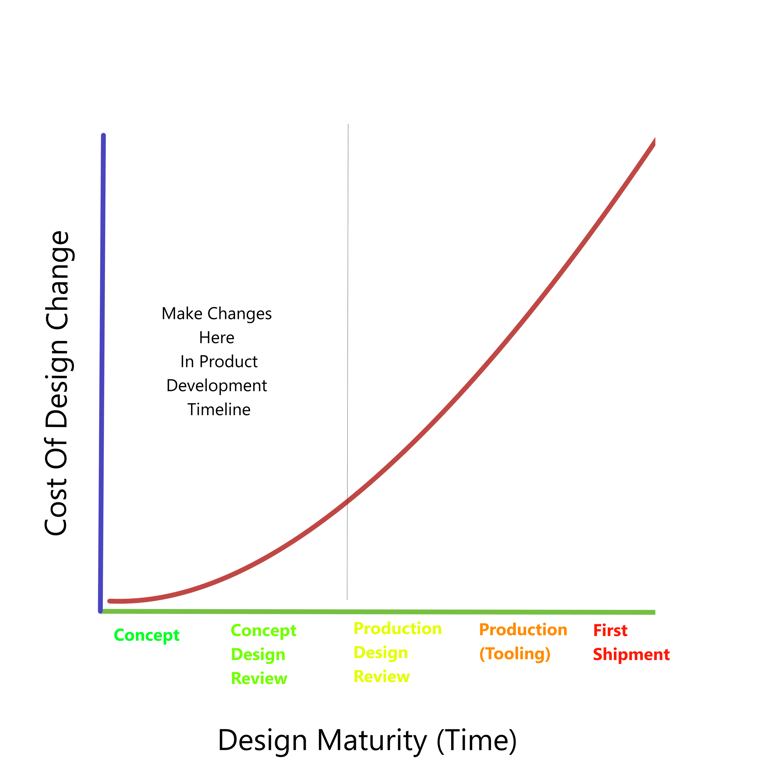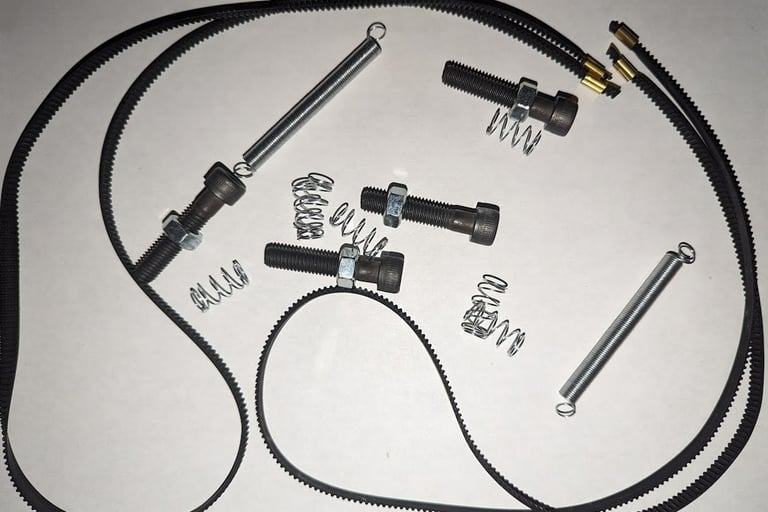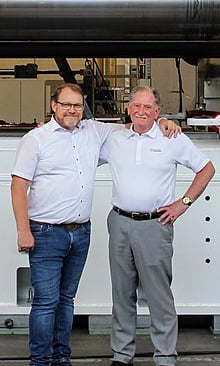Engineering Best Practices
So as it turns out, college is pretty hit-and-miss on preparing you for a career in engineering. The consensus I've heard from peers and students is that you learn a lot of stuff you never use and you don't learn the stuff that's actually useful. So, here, I decided to toss up some of the more useful things I've picked up over the years that have been pretty helpful.
~CCR


Note: This is a joke. Take a deep breath.
Munro Design Doctrine
Background:
Per Wikipedia, Sandy Munro is an automotive engineer who specializes in machine tools and manufacturing. At the prompting of my younger brother, I watched some of his content on YouTube a few years back and it was enlightening. He covered a lot of stuff that is extremely helpful but isn't mainstream for some reason. At least not in the circles I was running in at the time. What he teaches is extremely valuable and he's giving it away for free on his YouTube channel. So if any of the info is useful for you, make sure you go over there and watch some of his stuff.
The notes I have from his content will be in black. My own commentary will be in red.
Part Value Challenge:
Does the part have to move?
Moving parts are always going to be inherently more troublesome. From a math standpoint, dynamic systems are more difficult to design than static systems. From a wear and complexity standpoint, moving parts are always going to be more complicated and wear more than stationary parts. So if it's possible for a part to not move and still accomplish the intended design targets, then the static option should be used over the moving part option.
Does the part have to be a different material?
Like moving parts, different materials add complexity to a design. Different materials have different thermal expansion rates, different mechanical properties, different electrical properties, and different levels of susceptibility to corrosiveness. Using different materials also requires an assembly step which increases part cost. If the part can all be one material, it is easier to design and usually a better part.
Benchmarking High Five:
Identify what you do and how well you do it.
You need to know where you're at to know where you're going.
Identify who is doing what you do the best and analyze their product.
It pays to learn from the competition. If someone is kicking your butt, figure out why and figure out what you can do to outmaneuver your opponent.
Find out why and what the differences are. Determine the gaps between the best and your company analytically. Use numbers. No numbers no knowledge.
Subjective measures are seldom helpful. Telling your engineers that the competitor's product feels more comfortable is basically useless information. Telling your engineers that your competitors have more cab space, bigger seats, warmer and cooler HVAC, and two cup holders is actually useful information.
Learn from competitors and adopt the best practices.
It's to your benefit to learn from everyone. You don't have to copy everything you see but you should at least know the stuff and judge it on its merits.
Continuously improve.
This should be obvious.
All variation stems from design.
Variation here refers to product variation. Variation outside of functional parameters is what causes quality issues. Design engineering is ultimately responsible for just about everything. It would be difficult to find something the design engineers don't have at least a bit of culpability in.
The best design is the simplest one that works.
You should probably get this tattoo on the back of your hand.
The first design is never the simplest, the simplest design has the highest quality.
The reason for this is that the simplest design has the fewest things that can go wrong. Incidentally, sometimes the first design is the simplest that is used. Complexity creep is another problem you need to be wary of. The key point here is that you want the simplest working design possible.
Product design casts the biggest shadow. 70%. Material is 20% which is the next closest.
In other words, if you screw up the design, your SOL.
Question everything, believe nothing.
Asking questions is cheap. Not asking questions is expensive.
Do it right the first time, upfront, in the NPD design phase.
Once again, it's easiest to change on the front end of the design process. Waiting until later is a good way to increase costs and cause problems.
Make requirements less dumb. Everyone is wrong sometimes.
This is another example of overlap with Musk. When competent people are saying the same thing, there's probably some truth to it.
If we argue hard for our limitations we'll get to keep them.
Overcome your limitations.
Design for Bob, blindfolded, one-armed builder.
This goes back to designing parts that practically assemble themselves. There should be only one way to put the parts together. It should take only one hand to complete the assembly. You should also be able to assemble the parts with your eyes closed.
Automate last.
Automating before you have all of the bugs worked out results in very expensive changes.
Reiterating... DOES IT HAVE TO MOVE, OR DOES IT HAVE TO BE A DIFFERENT MATERIAL? NOT IS IT NOW, BUT DOES IT HAVE TO BE?
Once again, if a part can be stationary and made of only one material, it will have fewer quality issues and it will typically cost less and require less manufacturing to complete.
GET RID OF SPRINGS, GET RID OF FASTENERS, AND GET RID OF BELTS.
Most engineers use more fasteners than they need to. Springs, fasteners, and belts are all frequently failing parts. Springs and belts are also moving parts. If you can get rid of them, your product will be better for it.
CHALLENGE YOURSELF TO MAKE THE BEST PART POSSIBLE.
If you do this, the profits will follow.
Delete parts of the process.
As Musk also says, if you're not occasionally adding stuff back in, you're not deleting enough stuff.
Try very hard to delete parts. The bias is towards adding just in case it's needed. Cut down the number of parts. Put a name on every part added.
Reitterating this point. If you put names on parts, then people have an incentive to try to get rid of them so they have less stuff they need to be responsible for.
Putting names on parts makes people responsible for them.
This is a good way to hold members of your team accountable. This is also a good practice in general. If a task needs to get done, someone needs to be assigned it. There has to be a responsible party whose butt will be on the line at the end of the day if the task isn't completed.
Reiterating... DOES IT HAVE TO MOVE, OR DOES IT HAVE TO BE A DIFFERENT MATERIAL? NOT IS IT NOW, BUT DOES IT HAVE TO BE?
Once again, if a part can be stationary and made of only one material, it will have fewer quality issues and it will typically cost less and require less manufacturing to complete.
When in doubt, throw it out:
A learning curve for operators assembling a part is a sign of poor engineering.
In other words, a good engineer designs parts so that they only have one way they can go together. A well-designed product should just about assemble itself. Doing this takes a lot of effort and work but it pays off in the long run by reducing quality issues that are caused by improper assembly.
Every product has the capability of dropping the number of parts and effort required to assemble the product.
Very few products are optimized in this manner. There is usually always opportunity for improvement. Fewer parts and less assembly effort translate into fewer things that can go wrong which increases manufacturing speed and product quality.
Don't optimize something that doesn't need to exist. (Elon Musk says this too as you'll see below.)
There's not much that needs to be said about this one. Designing the perfect fuel system for an EV is a waste of time because the EV has a battery power system and doesn't require fuel.
As variation is reduced, quality will increase.
Reducing variation can be done by reducing the number of parts, reducing the complexity, reducing the tolerances, and a few other activities. In each case, taking out uncertainty from the product will improve the quality of the product.
Never do something just because it's always been done a certain way.
There is usually a reason something is done a certain way. The best practice is to find out what that reason is and then evaluate it from a first principles standpoint. if the process makes sense, it doesn't need to change. However, if the old way of doing it can be improved, then it should be improved. The key here is knowing why things are done the way they're being done.
You must be permanently dissatisfied in order to succeed.
This one is a hard truth but it's true never the less. If you grow content with where you're at, you will stop striving for excellence and continuous improvement.
Accelerate but only after you've perfected the product. If you're digging your grave, don't dig faster. (Another overlap with Musk.)
As the old saying goes, haste makes waste. Speeding through development and then producing a bunch of garbage products doesn't do anyone any good and it can potentially bankrupt your company in the process.
Ugly Baby Lesson:
Get in early at the concept phase, it's easier to make something good to start with than to try to fix it after the fact.
Below is a graph that illustrates this concept. It's called the "Cost of Design Changes in relation to product development phases". The time to change a product's design is right away in the process.
It's a one-way trip, so do it right the first time. The factory will adopt the ugly baby as theirs and resist any changes.
Once a design is in production, it is almost impossible to change. There are too many people who have been involved. Changing a product after production also makes you look like a fool so it's best to avoid it if possible.
A bad design can hang around for years.
A mess usually doesn't just go away. Typically, they need to get cleaned up. The worst-case situation is when a mess is incorporated into the foundation of future products. This can screw up countless future generations and permanently damn a product line to failure. Examples are picking bad CAD software, selecting a specific vehicle architecture, and incorporating lazy code into a system. You get the idea.
Tesla doesn't let ugly babies hand ground. If they find something they can change to make something better, they make the change.
Sandy cites Tesla as a company that's a good role model for not letting mistakes hang around.
When someone says something can't be changed, it's a sign that change needs to happen.
This isn't always true but it can be a good guide. Once again, the key is understanding why things are the way they are and then deciding based on that if they should be changed or not. For example, take cars. There is a reason they have four wheels instead of three wheels or five wheels. We wouldn't want to just change all cars to a five-wheel design unless we had an exceptionally good reason to justify going away from the four-wheel design.
Save Money Company:
Running scared, short-term objectives, cuts labor and materials, few upfront analytical methods, timing chart mentality, reactionary mode, shooting from the hip.
This applies to more than just companies. Short-term thinking in general has a tendency to screw you in the long run. This is an unfortunate fact of life that I especially hate when caramel rolls are around.
To go through each of Sandy's points here: Running scared is basically reacting to the market. It's just trying to survive and not trying to have an overarching vision that's directing your activities. Being short-term objective-oriented is like chasing after quarterly profits instead of making long-term investments in the future of the company. Cutting labor and material is exactly what it sounds like. When you lay off people, you lose the skills those people have. They can then go and get jobs working for your competition. Cutting material is like switching from steel gears to plastic gears. It saves you a lot of money but it decreases product quality. Upfront analytical methods... I'm not actually sure what he's talking about there. My best guess is not doing calculations and analysis on the front end of product development. Timing chart mentality is basically hitting deadlines even if it requires cutting corners and decreasing product quality. Reactionary mode is not having a proactive plan and just responding to things that happen to you as you go. Lastly, shooting from the hip is not actually taking the time to aim at things. It's quick and dirty but it's also wasteful and risky. If you miss, you're dead.
Make Money Company:
Invest in time and money, long-term goals, lead the market attitude, analytical approach, little politics, Munro customers lol.
There is less in the way of commentary for this one. I don't think there is anything I can add to what he said.
To get to the cheese, you can either go through the maze, or you can change the rules.
Sometimes, the only way to win a game is to not play it. For example, you would be wise to not try to win a face-slapping competition. Even if you win, you still get slapped in the face. This is another call for outside-of-the-box thinking.
Fewer parts, fewer operations, less tooling, and fewer quality problems = happier customers and more profits.
There isn't much to add to this one either. It's common sense yet it wasn't brought up a single time when I went to school. Make things as simple as possible. That will give you the most success.
Know yourself and know your enemy, win every battle - Sun Tzu
You need to know what you're good and bad at and you need to know what your enemy is good and bad at to ensure that you face your enemy using what you're good at in a situation that forces your enemy to use what your enemy is bad at. This will give you the greatest advantage.


GET RID OF SPRINGS, GET RID OF FASTENERS, AND GET RID OF BELTS.
Most engineers use more fasteners than they need to. Springs, fasteners, and belts are all frequently failing parts. Springs and belts are also moving parts. If you can get rid of them, your product will be better for it.
CHALLENGE YOURSELF TO MAKE THE BEST PART POSSIBLE.
If you do this, the profits will follow.
Delete parts of the process.
As Musk also says, if you're not occasionally adding stuff back in, you're not deleting enough stuff.
Try very hard to delete parts. The bias is towards adding just in case it's needed. Cut down the number of parts. Put a name on every part added.
Reitterating this point. If you put names on parts, then people have an incentive to try to get rid of them so they have less stuff they need to be responsible for.
Putting names on parts makes people responsible for them.
This is a good way to hold members of your team accountable. This is also a good practice in general. If a task needs to get done, someone needs to be assigned it. There has to be a responsible party whose butt will be on the line at the end of the day if the task isn't completed.


Get Musky
Background:
Elon is probably the most influential person of the modern era. At the very least a compelling argument to that effect could be made. Below are some nuggets of wisdom he has repeated on a number of occasions.
Elon Musk's Five Steps
Everyone is wrong some of the time.
If Musk, a multi-billionaire can admit he's wrong from time to time, we normal people should be able to do the same as well.
1. Question the requirements. (You should know why all the requirements exist. The biggest trap for a smart engineer is optimizing something that shouldn't exist).
The people making the requirements make mistakes from time to time as well. If they're not receiving pushback from their engineers then they don't have a feedback loop to drive improvement and they won't be learning.
2. Remove unnecessary process steps. (If you're not occasionally adding things back in, you're not deleting enough stuff).
Another point of agreement between Musk and Munro. Delete and simplify.
3. Simplify and Optimize (Simplest and most optimum design is best).
Simplify and then optimize. The order here is very important. The simplest solution is first, then optimize.
4. Accelerate time to learning (feedback on design. Testing etc. But only after steps 1,2, and 3).
Once you have the simplest design and it's optimized, test the crap out of it to make sure it works.
5. Automate (Last step).
Like what Monro said, don't automate until you have everything else sorted out. Automation makes further changes expensive.
Statistics
Key points from How to Lie with Statistics
By Darrell Huff
Questions to ask when getting the truth on figures...
Who says so?
Who is presenting the figures to you? What information are they trying to convey? You should take a college professor more seriously than a kindergartener but in both cases always evaluate the contents on their own merits.
Look for bias, special interests, that sort of stuff.
A company selling you infrared heating lamps will tell you that infrared radiation has no harmful effects on human skin. A dermatology company specializing in skin youth cream will tell you that infrared radiation is bad for your skin. In both these cases, the data presented is probably not to be trusted because of the conflict of interest of the source. It would be better to look for a third party with no interest in the matter one way or the other.
How does he/she know?
What was the nature of the study done to get the information? How were the conclusions drawn? What evidence is presented?
Watch for sample bias in polls. Data set size.
A small sample size is a red flag. Be on the lookout for it. Anything less than 100 is suspicious usually.
Is the sample representative?
Was the sample tested covering the whole population or were there specific groups that were excluded?
What's missing?
What data was thrown out? What are the people presenting the data not talking about? Is there anything obvious that seems to be lacking?
Did somebody change the subject?
The classic bait and switch. Is the data being presented consistent with the conclusion being drawn? Or when questioning, are the people presenting the data avoiding providing a straight answer?




